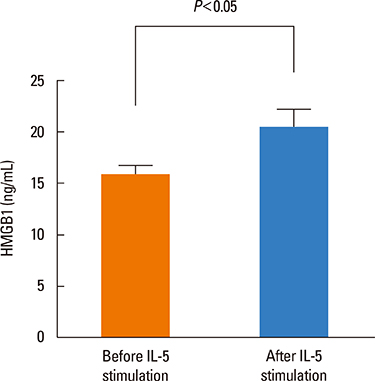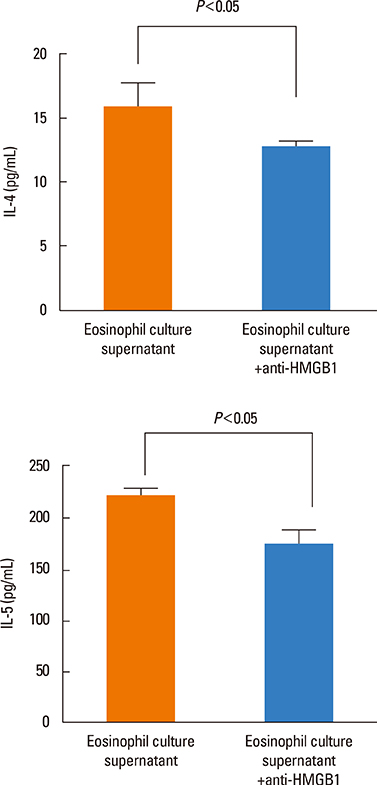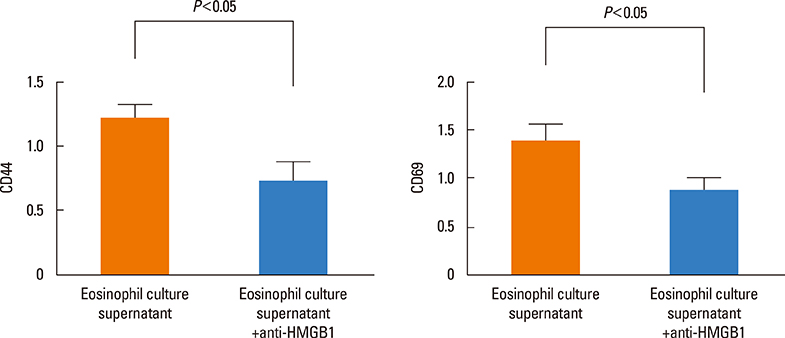Allergy Asthma Immunol Res.
2015 Mar;7(2):190-194. 10.4168/aair.2015.7.2.190.
Eosinophils Modulate CD4+ T Cell Responses via High Mobility Group Box-1 in the Pathogenesis of Asthma
- Affiliations
-
- 1Department of Internal Medicine, Seoul National University College of Medicine, Seoul, Korea. guinea71@snu.ac.kr
- 2Institute of Allergy and Clinical Immunology, Seoul National University College of Medicine, Seoul, Korea.
- KMID: 2365548
- DOI: http://doi.org/10.4168/aair.2015.7.2.190
Abstract
- Eosinophils have been reported to modulate T cell responses. Previously, we reported that high-mobility group box 1 protein (HMGB1) played a key role in the pathogenesis of asthma. This study was conducted to test our hypothesis that eosinophils could modulate T cell responses via HMGB1 in the pathogenesis of asthma characterized by eosinophilic airway inflammation. We performed in vitro experiments using eosinophils, dendritic cells (DCs), and CD4+ T cells obtained from a murine model of asthma. The supernatant of the eosinophil culture was found to significantly increase the levels of interleukin (IL)-4 and IL-5 in the supernatant of CD4+ T cells co-cultured with DCs. HMGB1 levels increased in the supernatant of the eosinophil culture stimulated with IL-5. Anti-HMGB1 antibodies significantly attenuated increases of IL-4 and IL-5 levels in the supernatant of CD4+ T cells co-cultured with DCs that were induced by the supernatant of the eosinophil culture. In addition, anti-HMGB1 antibodies significantly attenuated the expressions of activation markers (CD44 and CD69) on CD4+ T cells. Our data suggest that eosinophils modulate CD4+ T cell responses via HMGB1 in the pathogenesis of asthma.
MeSH Terms
Figure
Reference
-
1. Walsh ER, August A. Eosinophils and allergic airway disease: there is more to the story. Trends Immunol. 2010; 31:39–44.2. Jacobsen EA, Ochkur SI, Pero RS, Taranova AG, Protheroe CA, Colbert DC, et al. Allergic pulmonary inflammation in mice is dependent on eosinophil-induced recruitment of effector T cells. J Exp Med. 2008; 205:699–710.3. Walsh ER, Sahu N, Kearley J, Benjamin E, Kang BH, Humbles A, et al. Strain-specific requirement for eosinophils in the recruitment of T cells to the lung during the development of allergic asthma. J Exp Med. 2008; 205:1285–1292.4. Lotze MT, Tracey KJ. High-mobility group box 1 protein (HMGB1): nuclear weapon in the immune arsenal. Nat Rev Immunol. 2005; 5:331–342.5. Shim EJ, Chun E, Lee HS, Bang BR, Kim TW, Cho SH, et al. The role of high-mobility group box-1 (HMGB1) in the pathogenesis of asthma. Clin Exp Allergy. 2012; 42:958–965.6. Yanai H, Ban T, Taniguchi T. High-mobility group box family of proteins: ligand and sensor for innate immunity. Trends Immunol. 2012; 33:633–640.7. Ullah MA, Loh Z, Gan WJ, Zhang V, Yang H, Li JH, et al. Receptor for advanced glycation end products and its ligand high-mobility group box-1 mediate allergic airway sensitization and airway inflammation. J Allergy Clin Immunol. 2014; 134:440–450.e3.8. Borchers MT, Ansay T, DeSalle R, Daugherty BL, Shen H, Metzger M, et al. In vitro assessment of chemokine receptor-ligand interactions mediating mouse eosinophil migration. J Leukoc Biol. 2002; 71:1033–1041.9. Liu L, Inoue H, Nakayama H, Kanno R, Kanno M. The endogenous danger signal uric acid augments contact hypersensitivity responses in mice. Pathobiology. 2007; 74:177–185.10. Shen HH, Ochkur SI, McGarry MP, Crosby JR, Hines EM, Borchers MT, et al. A causative relationship exists between eosinophils and the development of allergic pulmonary pathologies in the mouse. J Immunol. 2003; 170:3296–3305.11. Bianchi ME, Manfredi AA. High-mobility group box 1 (HMGB1) protein at the crossroads between innate and adaptive immunity. Immunol Rev. 2007; 220:35–46.12. Messmer D, Yang H, Telusma G, Knoll F, Li J, Messmer B, et al. High mobility group box protein 1: an endogenous signal for dendritic cell maturation and Th1 polarization. J Immunol. 2004; 173:307–313.13. Marrugo J, Marsh DG, Ghosh B. The conserved lymphokine element-0 in the IL5 promoter binds to a high mobility group-1 protein. Mol Immunol. 1996; 33:1119–1125.14. Masuda ES, Tokumitsu H, Tsuboi A, Shlomai J, Hung P, Arai K, et al. The granulocyte-macrophage colony-stimulating factor promoter cis-acting element CLE0 mediates induction signals in T cells and is recognized by factors related to AP1 and NFAT. Mol Cell Biol. 1993; 13:7399–7407.15. Kyostio-Moore S, Nambiar B, Hutto E, Ewing PJ, Piraino S, Berthelette P, et al. STR/ort mice, a model for spontaneous osteoarthritis, exhibit elevated levels of both local and systemic inflammatory markers. Comp Med. 2011; 61:346–355.16. Chen D, Mao M, Bellussi LM, Passali D, Chen L. Increase of high mobility group box chromosomal protein 1 in eosinophilic chronic rhinosinusitis with nasal polyps. Int Forum Allergy Rhinol. 2014; 4:453–462.
- Full Text Links
- Actions
-
Cited
- CITED
-
- Close
- Share
- Similar articles
-
- Relationship between T cell subset and clinical characteristics in bronchlal asthma
- Eosinophilic Bronchitis, Eosinophilia Associated Genetic Variants, and Notch Signaling in Asthma
- Eosinophils and childhood asthma
- Eosinophils are Required for Immune Responses Induced by Oral Immunization
- Which Factors Associated With Activated Eosinophils Contribute to the Pathogenesis of Aspirin-Exacerbated Respiratory Disease?





